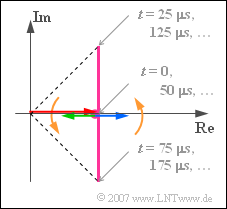Difference between revisions of "Aufgaben:Exercise 4.5Z: Simple Phase Modulator"
m (Text replacement - "Category:Exercises for Signal Representation" to "Category:Signal Representation: Exercises") |
|||
| Line 126: | Line 126: | ||
__NOEDITSECTION__ | __NOEDITSECTION__ | ||
| − | [[Category: | + | [[Category:Signal Representation: Exercises|^4.3 Equivalent Low Pass Signal and Its Spectral Function^]] |
Revision as of 13:38, 23 March 2021
The diagram shows a quite simple arrangement for approximating a phase modulator. All signals are dimensionless quantities.
The sinusoidal message signal $q(t)$ of frequency $f_{\rm N} = 10 \ \text{kHz}$ is multiplied by the signal $m(t)$ , which results from the cosinusoidal carrier signal $z(t)$ by phase shifting by $\phi = 90^\circ$ :
- $$m(t) = {\cos} ( \omega_{\rm T} \cdot t + 90^\circ).$$
Then the signal $z(t)$ with the frequency $f_{\rm T} = 1 \ \text{MHz}$ is still added directly.
For abbreviation purposes, this task also uses:
- the difference frequency $f_{\rm \Delta} = f_{\rm T} - f_{\rm N} = 0.99 \ \text{MHz}$,
- the sum frequency $f_{\rm \Sigma} = f_{\rm T} + f_{\rm N} = 1.01\ \text{MHz}$,
- the two angular frequencies $\omega_{\rm \Delta} = 2\pi \cdot f_{\rm \Delta}$ and $\omega_{\rm \Sigma} = 2\pi \cdot f_{\rm \Sigma}$.
Hints:
- This exercise belongs to the chapter Equivalent Low Pass Signal and Its Spectral Function.
- Consider the trigonomic transformations
- $$\sin(\alpha) \cdot \cos (\beta)= {1}/{2} \cdot \sin(\alpha - \beta) + {1}/{2} \cdot \sin(\alpha + \beta),$$
- $$\sin(\alpha) \cdot \sin (\beta)= {1}/{2} \cdot \cos(\alpha - \beta) - {1}/{2} \cdot \cos(\alpha + \beta).$$
Questions
Solution
- Due to the phase shift by $\phi = 90^\circ$ the cosine function becomes the minus-sine function.
- With $q(t) = \sin(\omega_{\rm N} t)$ holds:
- $${s(t)} = \cos({ \omega_{\rm T}\hspace{0.05cm} t }) - \sin({ \omega_{\rm T}\hspace{0.05cm} t }) \cdot \sin({ \omega_{\rm N}\hspace{0.05cm} t }) = \cos({ \omega_{\rm T}\hspace{0.05cm} t }) - 0.5 \cdot \cos(({ \omega_{\rm T}-\omega_{\rm N})\hspace{0.05cm} t }) + 0.5 \cdot \cos(({ \omega_{\rm T}+\omega_{\rm N})\hspace{0.05cm} t }).$$
(2) The spectrum of the analytical signal is:
- $$S_{\rm +}(f) = \delta (f - f_{\rm T}) - 0.5 \cdot \delta (f - f_{\rm \Delta})+ 0.5 \cdot \delta (f - f_{\rm \Sigma}) .$$
- By shitfing $f_{\rm T}$ one arrives at the spectrum of the equivalent low pass signal:
- $$S_{\rm TP}(f) = \delta (f ) - 0.5 \cdot \delta (f + f_{\rm N})+ 0.5 \cdot \delta (f - f_{\rm N}) .$$
- This leads to the time function
- $$s_{\rm TP}(t) = {\rm 1 } - 0.5 \cdot {\rm e}^{{-\rm j}\hspace{0.05cm} \omega_{\rm N} \hspace{0.05cm} t }+ 0.5 \cdot {\rm e}^{{\rm j}\hspace{0.05cm} \omega_{\rm N} \hspace{0.05cm} t } = 1 + {\rm j} \cdot \sin(\omega_{\rm N} \hspace{0.05cm} t ).$$
- At time $t = 0$ ist $s_{\rm TP}(t) = 1$, is real. Thus:
- $s_{\rm I}(t = 0) = \text{Re}[s_{\rm TP}(t = 0)]\; \underline{= 1}$,
- $s_{\rm Q}(t = 0) = \text{Ime}[s_{\rm TP}(t = 0)]\; \underline{= 0}$.
(3) The locus curve is a vertical straight line ⇒ Proposition 3 with the following values:
- $$s_{\rm TP}(t = 0) = s_{\rm TP}(t = {\rm 50 \hspace{0.05cm} µ s}) = \text{ ...} = 1,$$
- $$s_{\rm TP}(t = {\rm 25 \hspace{0.05cm} µ s}) = s_{\rm TP}(t = {\rm 125 \hspace{0.05cm} \mu s}) = \text{ ...} = 1 + {\rm j},$$
- $$s_{\rm TP}(t = {\rm 75 \hspace{0.05cm} µ s}) = s_{\rm TP}(t = {\rm 175 \hspace{0.05cm} \mu s}) = \text{ ...} = 1 - {\rm j}.$$
(4) The magnitude (the pointer length) varies between $a_{\rm max} = \sqrt{2}\; \underline{\approx 1.414}$ and $a_{\rm min} \;\underline{= 1}$. It holds:
- $$a(t) = \sqrt{1 + \sin^2(\omega_{\rm N} \hspace{0.05cm} t )}.$$
With ideal phase modulation, on the other hand, the envelope $a(t)$ would have to be constant.
(5) The real part is always $1$, the imaginary part equal to $\sin(\omega_{\rm N} \cdot t) $. From this follows the phase function:
- $$\phi(t)= {\rm arctan} \hspace{0.1cm}{\left(\sin(\omega_{\rm N} \hspace{0.05cm} t )\right)}.$$
- The maximum value of the sine function is $1$. From this follows:
- $$\phi_{\rm max} = \arctan (1) \; \underline{= \pi /4 } \; \Rightarrow \; \underline{45^\circ}.$$

